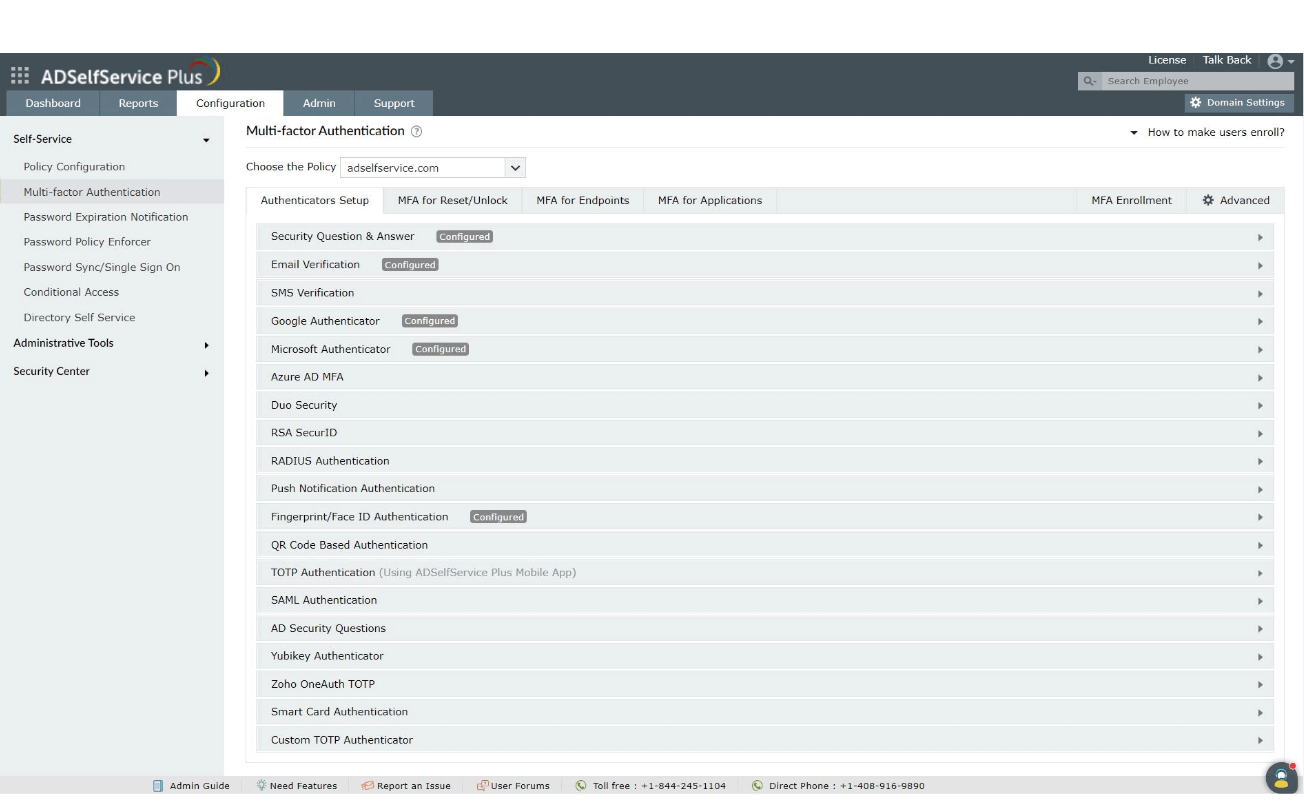What is endpoint security and why is it important?
Endpoint security is the practice of guarding the endpoints in your organization against attacks or vulnerabilities. Corporate endpoints can include servers, workstations, mobile devices, laptops, and desktops, and attackers commonly view these as their entry points into the network. Even a poorly guarded end-user workstation can become a weapon, as threat users claim illicit access to resources and infiltrate the network with malware. This is why it is important to strengthen your organization's endpoint security and the best way is with an endpoint security tool. Deploying an efficient endpoint security solution barricades prevalent cyberattacks aimed at endpoints and simplifies security management for your organization.
Get MFA-protected endpoints with ADSelfService Plus
- Secure your organizational endpoints endpoints like machines, VPNs, OWAs, RDPs, and any RADIUS or IIS-based network endpoints with adaptive MFA.
- Choose from 20 different authentication methods for your users to verify their identities with.
- Enable conditional access with conditions like the user's location, IP address, time of access, and device used.
- Configure different MFA flows for users based on their OU, group, and domain memberships.

Salient features of ADSelfService Plus' endpoint MFA capability
MFA for machine logons
Protect logons to Windows, Mac, and Linux workstations and servers with adaptive MFA, which is triggered based on the user account during logon.
Learn moreDevice-based MFA
Safeguard logons to critical machines with adaptive MFA, which is triggered based on the device's policy settings, irrespective of the user logging in to the machine.
Learn moreOffline MFA
Secure your offline remote users by enabling MFA for offline Windows and macOS machine logons.
Learn moreMFA for VPN
Fortify VPN connections to your organization's networks and other network endpoints that use RADIUS with adaptive MFA.
Learn moreADSelfService Plus'
endpoint MFA in action
Here's how user-based Windows logon MFA works
- Users logging in to Windows machines first prove their identities using their AD domain credentials.
- Next, they authenticate themselves using a time-sensitive authentication code sent via SMS or email, biometrics, or through a third-party authentication provider.
- Depending on the administrator's configurations, they may need to authenticate themselves through one or more methods.
- Finally, users log in to their Windows machines once they have successfully authenticated themselves.
-
Better resilience and reputation
Keep attackers from exploiting your endpoints and earn a good security repute for your company.
-
Enhanced user experience
Use different authentication methods for users with different privileges by configuring MFA techniques based on their OU, group, and domain memberships.
Benefits of securing your endpoints using ADSelfService Plus
-
Wide variety of authenticators
Choose from multiple authentication factors that ADSelfService Plus offers to provide MFA for your endpoints.
-
Compliance with regulatory norms
Meet the NIST SP 800-63B, GDPR, and HIPAA compliance mandates by guarding resources with MFA rather than just passwords.
How to enable MFA for your endpoints with ADSelfService Plus
-
1
How to enable MFA for machine logons
To enable MFA for machine logons you need to install ADSelfService Plus' login agent for Windows, macOS, and Linux.
View guide -
4
2
How to enable MFA for OWA
With ADSelfService Plus, you can enable MFA for OWA and Exchange Admin Center logons.
View guide
-
2
3
How to enable device-based MFA for your machines
Device-based or machine-based MFA protects business-critical machines by mandating MFA for every user who logs on to the device.
View guide -
5
4
How to enable MFA for RDP
ADSelfService Plus allows for RDP MFA to be configured in two ways, namely RDP server authentication and RDP client authentication.
View guide

